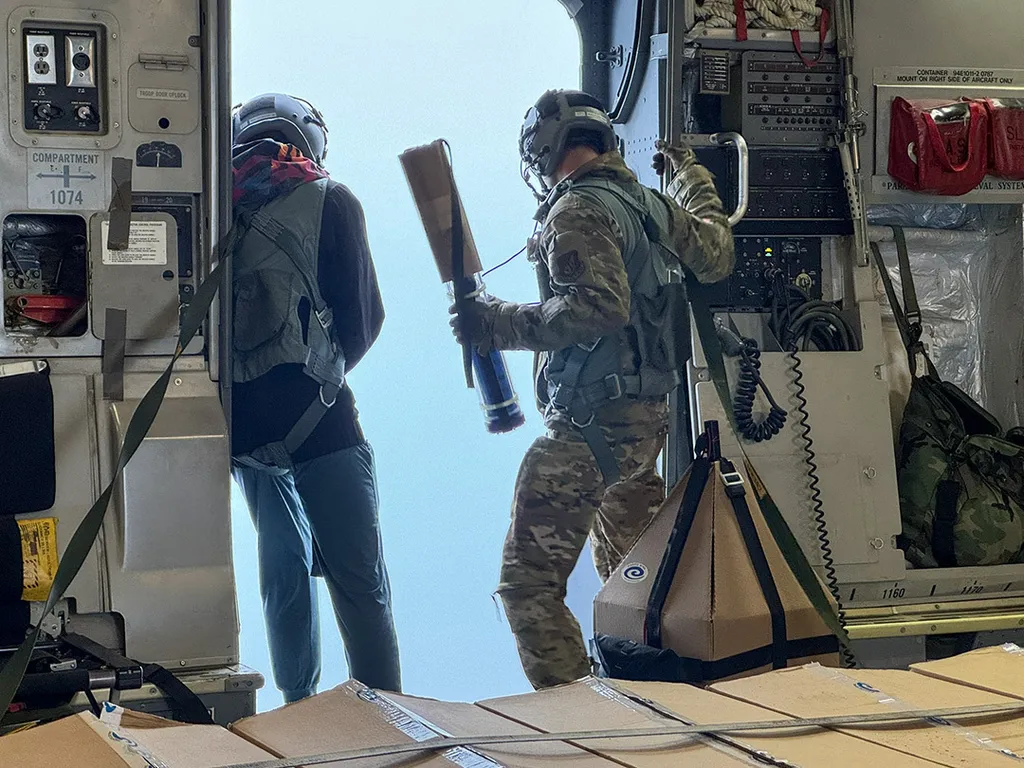- April 11, 2025
- By Ruby Siefken ’26
Nathan Roy ‘25 is nearly hanging out the side door of the Alaska Air National Guard’s C-17, a wall of freezing air turning his cheeks rosy. Thirty thousand feet below, the vast Arctic Ocean churns, tossing floating icebergs through its frigid waves.
Roy pitches his custom-made research buoy out of the plane and it plummets. For a moment, the 15-pound PVC pipe creation tumbles weightlessly, twisting in the icy air as the plane speeds away. Then—snap!—the parachute deploys, flipping the device upright and slowing its descent like a drifting snowflake.
This scene played out last summer in early August—an example of the broad range of unique research opportunities available to University of Maryland students. The buoy will remain in the Arctic Ocean for about a year before its battery expires and it must be replaced. Roy is finishing up his final semester studying aerospace engineering at UMD while refining the buoy’s design for future drops. After graduation in May, meanwhile, he’s slated to begin a full-time position with SpaceX.
Since 2023, Roy has been working with UMD Assistant Professor of Art Cy Keener on the Arctic sea ice research and design project. The pair has designed and deployed more than 20 iterations of the device—five of which are currently in the Arctic Ocean.
Seeing the impact of Roy’s research is as easy as opening the weather app on your phone, because the buoy's hourly data directly contributes to the weather models that support daily forecasts.

Roy’s buoy uses GPS location, surface temperature and pressure meters to gather sea ice composition and movement data. Once the buoys are in the water or frozen into an ice sheet, data analysts from the International Arctic Buoy Program manage and interpret the data. This information allows researchers to identify thickness, movement and shape of glaciers in different regions, contribute to weather forecasts and track warming and melting phenomena.
“The buoys are made to give us a better understanding of our planet and the way that it works,” Roy said. “If you don’t understand icebergs, you can’t predict them,”
Keener made his first trip to the Arctic to study sea ice in 2019. He has deployed dozens of sensors and uses the data to collaborate with other universities and research programs to learn more about our planet—and create art. He’s made the trip to the Arctic Ocean seven times in the past year.
When Keener brought Roy onto the research team, the artist already had an operational buoy design, but lacked the engineering background to improve it.
“In art, you get to define your own problem. In engineering, usually someone else is defining the problem for you,” Keener said. “This is Nathan’s buoy now.”
Roy first took Keener’s basic design and “ruggedized it,” making it possible to survive a plunge from an airplane at 20 feet per second. The buoy that Roy dropped last summer is completely his own—he engineered, coded, assembled, tested and deployed the device.
“It’s really cool to build something and see it work, and now I can pull up my computer at any time and look at the data—my data,” Roy said. “It’s not just a little robot that I made for class sitting on a shelf somewhere.”
The device Roy dropped last summer is nearing the end of its lifespan, even with its 108 AA batteries. Typically, each buoy is operational for about 18 months.
“Unless it gets demolished by a polar bear,” Roy added. “It’s happened before.”
Now, the pair is looking to share its design so other researchers can collect data of their own. They’re also planning to enhance the design with light and temperature sensors on the buoy’s exterior to track sea ice thickness and improve satellite data—and maybe add polar bear repellent.
All through April, Maryland Today will celebrate how the University of Maryland is reimagining learning and teaching. Find more stories at today.umd.edu/topic/we-reimagine-learning.
